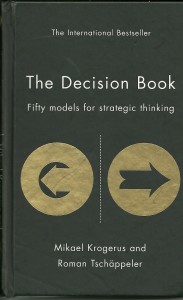The one-sentence summary
Strategic visual tools can help simplify any problem and suggest steps towards a decent decision.
WHAT THE BOOK SAYS 
- The authors have gathered together fifty models for strategic thinking in one small book. Whether you need to plan a presentation, assess someone’s business idea or just get to know yourself better, the visual tools will help simplify any problem and suggest steps towards a decent decision.
- There is a wide range of material, from MBA courses and lighter business reading to personal improvement.
- In one diagram that performs the role of the contents page, they show how the models cover me v. others and thinking v. doing, which generates four quadrants: how to improve (myself/others), and how to understand better (myself/others). Highlights from each section are:
- Improve yourself: the Eisenhower priority matrix, the rubber band model (what is holding or pulling you?), the feedback model ((advice, compliment, criticism, suggestion), and the conflict resolution model (flight, fight, give up, evade responsibility, compromise, reach a consensus).
- Understand yourself better: the flow model (under/over challenged, or ‘in the flow’?), the Johari Window (what I know about others and what they know about me), the energy model (are you memory-, dream-, or reality-driven?), and the personal performance model (have to, able to, want to).
- Understand others better: the Swiss cheese model (in the analogy, mistakes only happen when all the holes in every slice line up and something slips through the layers), double loop learning (learning properly from your mistakes), long tails and black swans.
- Improve others: the Hersey-Blanchard model of situational leadership (adapt your approach from instruct to coach, support, delegate), and the Drexler-Sibbet team performance model 9they never seem to have normal names do they?). This one takes you from orientation to renewal in 7 steps.
WHAT’S GOOD ABOUT IT
- You should be able to select a model for almost any situation to provide a different perspective, or to get some structure round all the variables.
- There is a “Now it’s your turn” section at the back that encourages you to draw a range of possible solutions. Most models are inherently visual, and the authors believe it is good to draw while you talk, and use pictures to articulate what words cannot.
WHAT YOU HAVE TO WATCH
- You need to keep an eye on the old chestnuts and decide whether they are any good, not very helpful, or just plain overused: SWOT analysis, Maslow’s pyramids, thinking outside the box, the Pareto principle (80:20) rule, de Bono’s hats, and several others.
